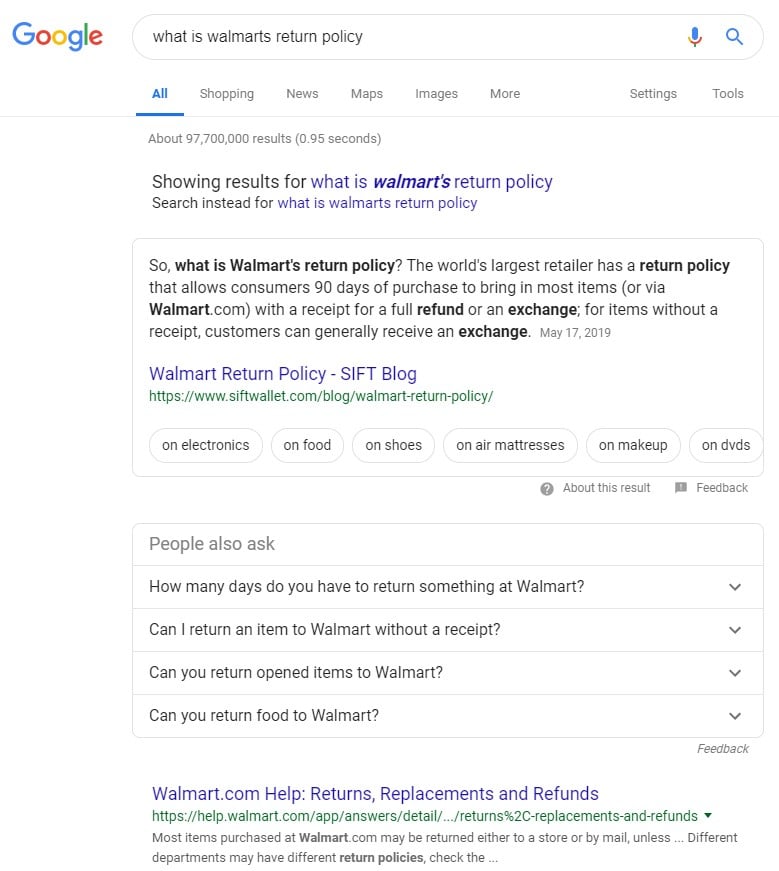
30 May SEO: Can Ecommerce Sites Win the Answer Box?
The “answer box” is Google’s way of responding to questions directly from the top of the search results page so that searchers don’t need to leave that page to get answers. Each answer box contains a link to the source site, and usually an image as well. The answer appears in a light-gray box, drawing even more attention to it.
Can ecommerce sites win the answer box? Absolutely.
In the example below, Cars.com answers the question, “what does ABS mean in a car?” Searchers ask Google this question an average of 4,400 times per month. Cars.com wins brand impressions for every one of them. Cars.com’s extensive informational content is suitable for Google’s answer box, as well as ranking for long tail search queries in general.

Google’s answer box, populated by content from top etailer Cars.com.
For search-engine-optimization practitioners, the primary allure of the answer box is its placement in “position zero” — above the first organic search result. If query also returns ads, those ads will display first, then the answer box, and then organic results. Whether ads are present or not, the answer box is now the highest organic ranking position on the search results page.
In addition to the extra visibility, the answer box is also critical to winning the voice search game. Last year, Gartner predicted that by 2020 30 percent of searches will be done on a voice device, such as Amazon Echo and Google Home.
There is only one result in voice search. And what feeds that one spoken search result? For 80 percent of Google Home’s search results, it’s the answer box, according to a study by Roast, a digital marketing agency.
Ecommerce Sites
Ecommerce sites can compete with content-rich and how-to sites for the answer box. Ecommerce sites should respond to product-related questions that people search for when they’re researching what to buy, how to buy, or how to use or fix something they already own.
Exclusive data from enterprise platform seoClarity shows that the top 10 shopping sites are collectively eligible to appear in answer boxes for more than 453,000 search queries. They capture that answer box 11 percent of the time, on average.
For the study, seoClarity selected the top 10 sites from Alexa’s top 500 shopping sites list. Those 10 are HomeDepot.com, Walmart.com, eBay.com, BestBuy.com, Wayfair.com, Etsy.com, Lowes.com, Target.com, Cars.com, and Macys.com.
seoClarity then defined “eligibility” as ranking in the top three positions in Google for a query that triggers an answer box. Why the top three? Because seoClarity’s data shows that the answer box is populated by one of the top-three sites 98 percent of the time.
For example, the chart below shows that HomeDepot.com ranks in the top three positions for more than 97,000 search queries that trigger an answer box. Of those, HomeDepot.com wins the answer box 9,000 instances, 9 percent of the time. Walmart.com is eligible for fewer answer boxes (roughly 65,000) but converts higher at 14 percent.

Top ecommerce brands that rank for answer box queries. Source: seoClarity.
Thus ecommerce sites can rank highly for answer box queries. And failure to win those answer box placements can teach us much.
Branded Queries
A subset of answer-box search queries contains brand terms, such as “What is Walmart’s return policy?” and “Does Home Depot give a military discount?” These drive thousands of searches per month. The brands’ sites contain content to answer the questions. But they’re not winning the answer box.
Other sites are controlling the conversation around their brand.
The chart below illustrates the millions of searches per month where top ecommerce brands lose the opportunity to control the conversation around their own brand in Google’s answer boxes.

Top ecommerce brands miss opportunities to rank in answer boxes for branded search queries that drive millions of searches a month. Source: seoClarity.
In the example below, “what is Walmart’s return policy?” is answered by Siftwallet.com. Somewhere around 2,400 monthly searches occur on Google for this query, but Walmart doesn’t own the answer box that provides the answer.

Siftwallet.com wins the answer box for “what is Walmart’s return policy?”
Is Siftwallet.com’s answer correct? When Walmart changes its policy, does Sift update its page?
Why doesn’t Walmart win the answer box? Does it have a page that answers this question?
The short answer is “yes.” But Walmart’s return policy page shown in the screenshot below contains stiff language likely written by a lawyer. It doesn’t directly answer the common questions — how long and whether it will be a full refund or an exchange — in a way that Google could grab for its answer box.

Walmart’s return policy page doesn’t appeal to Google’s answer box algorithm.
Short and Direct
Why do some of the biggest brands in ecommerce have difficulty winning the answer box, even when the search query contains their own brand? Mainly because the content doesn’t answer a question in a couple of short lines.
Sources

